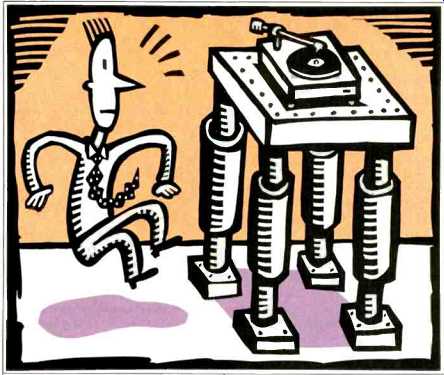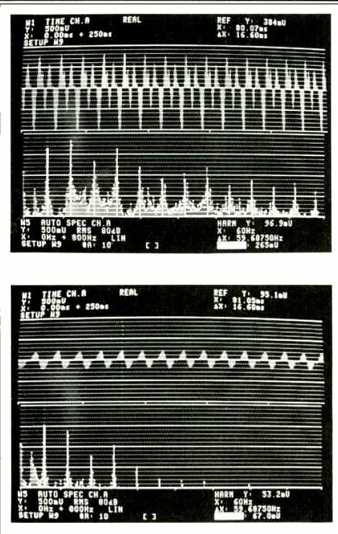PUT ON YOUR HAPPY FEET

From the earliest days of the high-fidelity era, audiophiles have indulged in the fine art of "tweaking," in order to enhance and improve the performance of their audio component systems. Audiophiles quickly learned that tweaking was most sonically and musically rewarding when applied to the elimination or suppression of the various omnipresent resonances, vibrations, and extraneous noises that can degrade performance.
Except for a few modern designs, speaker enclosures are usually a prime source of resonances. Early audiophiles often went to the expense and trouble of building enclosures with sand-filled walls or constructing them of brick or concrete. When the vinyl LP record was the only game in town, some people would tweak their playback systems by employing the brute-force/high-mass philosophy of mounting their turntables on 3/4-inch steel boilerplate bolted to a cubic yard of granite. Or they would take the route of elaborate isolation of the turntable by means of springs with pneumatic or hydraulic shock-mounting.
Not much of this kind of tweaking goes on these days. In fact, since the ascendancy of the CD, it is said that one reason diehard analog enthusiasts hate CDs is that CD players are not amenable to tweaking.
However, the laws of physics have not changed, and resonances and vibrations are still very much with us in the current audio scene. Notwithstanding this, most of today's tweaking activity involves component interconnect cables and speaker wire. I hardly need mention that this is a very controversial subject. Extravagant claims of superior performance when using certain wires and cables are made on the basis of purely subjective evaluation. These assertions are challenged by the more conservative scientific and engineering people, who contend that unless the claims can be verified by double-blind testing or objective measurements, they are invalid. Needless to say, there have been many mud-slinging exchanges between the two groups, with plenty of such epithets as "tin-eared," "hidebound," "dreamers," etc. bandied about. Alas, the arguments will continue to rage, for at least in the case of wires and cables, no one has been able to devise a test that will satisfy all parties.
Today's audiophiles are well aware of the detrimental effects of resonances and vibrations, especially with respect to structure-borne and airborne acoustic feedback, that can cause problems in turntables, CD and cassette players, loudspeakers, and even preamplifiers and amplifiers.
Over the years I've ardently championed any device, material, or procedure that would keep the relentless attacks of resonances and vibration on music signals at bay. Perhaps I am unduly sensitive to acoustic phenomena which affect music reproduction in the home. But, in my view, the cumulative effects of the multiple resonances originating in an audio component system produce an acoustic overlay or veiling, an unpleasant sonic coloration that significantly degrades the purity of music signals. Although resonance is a vitally essential element in determining the sound quality of musical instruments, it cannot be tolerated in an audio component system.
To help ameliorate sonic anomalies, much tweaking is done using various kinds of isolation feet or dampers.
These are made of a variety of absorbent materials such as butyl, neoprene, raw silicone rubber, Sintra (rigid foam), Ear-lsodamp, Sorbothane, Kydex, and Isotec. Here again, some rather enthusiastic subjective claims as to the devices' efficacy in suppressing resonances and vibrations are not usually verified by objective measurements. In spite of the lack of verification in the lab, I have used a number of these devices. In varying degrees, they do seem to work, albeit not dramatically, in providing a cleaner signal.
As you can imagine, hi-fi editors receive many unsolicited audio accessory devices and products. Frankly, a large percentage of them are little more than gimmicks. Their makers promise improved performance of several sonic parameters; after evaluation, the improvements turn out to be rather nebulous or nonexistent. Moreover, these products are rarely accompanied by any kind of test data. In spite of this, once in a while one finds some gold among the dross.
Recently, I received a quantity of isolation feet called Sims Silencers made by Sims Vibration Dynamics of Redmond, Washington. I expected these to be just another ho-hum version of a device already glutting the audio marketplace. I was pleasantly surprised to find that fairly extensive documentation of test measurements on the product had been furnished as well. Even more cheering was that when I placed the Sims Silencers underneath a turntable, they worked with remarkable efficiency, having very salutory effects on the perceived quality of the sound. The anti-resonance/vibration performance indicated by the accompanying test data and graphs was fully supported by the audible evidence of my subjective impressions.
Sims states that the Silencers should be placed underneath the chassis of an audio component, not underneath the rubber feet that are an integral part of the component. The Silencers are 2 inches in diameter and 1 inch thick. A heavy half-inch-wide aluminum compression ring surrounds the proprietary damping compound, which Sims calls NAVCOM, an acronym for Noise and Vibration Counter Measure. NAVCOM is a black, visco-elastic long-chain polymer, an amorphous rubber-like substance with a dense, close-knit grain structure. It has a very low modulus of elasticity and a natural resonant frequency well below the lowest frequencies of the audio bandwidth. It is very difficult to compress-so much so that one Silencer will support up to 35 pounds. NAVCOM is effective over a frequency range of 10 Hz to 30 kHz.
Transient vibrations and impulsive shock energy are blocked by its molecules and dissipated as heat.
Sims has conducted interesting experiments to verify the vibration-damping qualities of NAVCOM. In one rather crude, but dramatic, test, a bench grinder was mounted on a lab table, and a glass of water was placed on various competitive isolation feet and on a Sims NAVCOM Silencer. When the bench grinder was operated, the vibration agitated the surface of the water, to varying degrees, in the glasses supported by the other feet but left the water unruffled in the glass mounted on the NAVCOM Silencer.
Sims sent me graphs of test results for, among others, butyl, neoprene, and Sorbothane plus their NAVCOM. The tests were made to calculate vibration modal amplitudes and decay time for each damping material. A high-resolution FFT spectrum analyzer generated the test impulse for each sample under analysis, and a Body sonic vibro-tactile transducer reproduced the test impulse for recording.
The pickup sensor was a Pennwalt high-polymer accelerometer placed on top of each sample. The Body-sonic was placed on a test stand, which was on a wood parquet over concrete floor.
The test computer repeated each test 16 times and calculated an average value. Each resulting graph illustrates the amplitude of the generated wave (as a function of maximum change in decibels) versus the decay time (in milliseconds).

above: B & K's reference test of vibration effects without isolation.
B & K test of vibration effects using Sims NAVCOM damping material.
These graphs were most informative and revealing. Of the seven materials tested along with NAVCOM, all showed the sharp, transient, high-amplitude spikes of the initial impulse and then attenuation of the spikes at a rate and over a time period reflecting the damping qualities of the specific material. The NAVCOM graph was amazing-perhaps a tiny ripple representing the initial impulse, and virtually no decay time.
The impressive NAVCOM graph correlates well with what I heard. With the NAVCOM Silencers in place, it was immediately apparent how much cleaner music sounded, regardless of the source. The bass was notably tighter and better defined, while the midrange and top end exhibited more detail. The sound was far more open, with more air around the instruments, and there was a better perception of depth along with a more precise and stable stereo image. It was obvious that cumulative effects of various resonances and vibrations emanating from my system's components had been causing an acoustic veiling, superimposed on the music signals.
Steve Sims, in a phone conversation, told me of still another way to "gild the audio lily"-placing loudspeakers on a wooden platform laminated with NAVCOM. He also told me he had obtained some new measurements on NAVCOM, through tests independently conducted by the Seattle office of test instrument manufacturer Bruel & Kjaer.
Shorty thereafter, I received the Bruel & Kjaer test data and a platform for my Duntech Sovereign loudspeakers. The platform is of two half-inch thick pieces of particleboard (nicely finished in rosewood to match the speakers) with a quarter-inch-thick sheet of NAVCOM laminated between them. Two husky friends placed my 376-pound speakers on the Sims platforms, whose undersides are fitted with eight floor spikes apiece. Of course, floor spikes have been used underneath speakers for some time, as an aid in getting cleaner bass. But inevitably, the energy that is transmitted to the floor is reflected back through the spikes into the speaker, though perhaps at a reduced level. The Sims speaker platform's NAVCOM laminate prevents this. The results were that another acoustic veil had been stripped from music. The improvement in midrange and treble articulation was quite remarkable, and bass response was so very natural and free of coloration.
The Bruel & Kjaer tests employed their Model 2032 FFT spectrum analyzer. The setup was the same Sims had used-that is, generating a test impulse and sending it to the sample material, with an accelerometer picking up the vibrations and returning them to the analyzer. Results from two tests, photographed from the B & K 2032's display screen, are shown here.
Each top trace is of a signal in the time domain, 250 mS long, that is passing through the material under test. Each lower trace is the fast Fourier transform of the signal, showing the amplitude in the frequency domain, with the band of interest from 0 to 800 Hz. Both test photos represent suppression of vibration as measured in G forces. In the notations on the lower right of each graph, note that the bottom figure is the result of the test, expressed in milli gravities. The first graph is a reference, run with no isolation whatever. You can see the prominent spikes in both the time and frequency domains. They measure 265 milligravities. The other test presented here was for NAVCOM, and it shows suppression of vibration all the way down to 67 milligravities.
Obviously, there is a strong correlation between this measured data and what I heard.
Thus, it is possible to tweak a system with certain devices and have the improvements you hear verified by generally accepted measurement standards. Fortunately, tweaking with Sims Silencers is relatively inexpensive; a set of four lists for $68. The Sovereign version of the Sims NAVCOM speaker platform, 20 1/4 x 34 3/4 inches, costs $395 for a pair. Smaller platforms will range in price from $225 to $295.
Information on dealers who handle Sims products is available from: Sims Vibration Dynamics, 2797 152nd Ave. N.E., Redmond, Wash. 98052.
(adapted from Audio magazine, July 1989; Bert Whyte)
= = = =